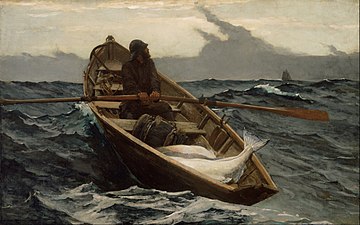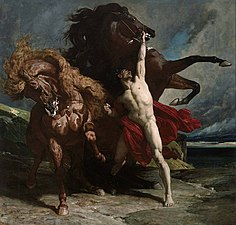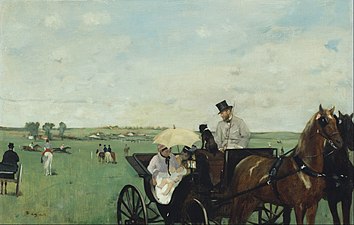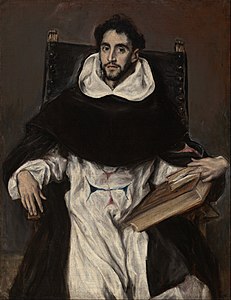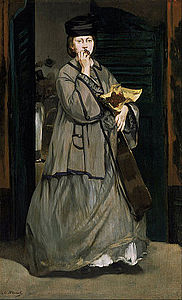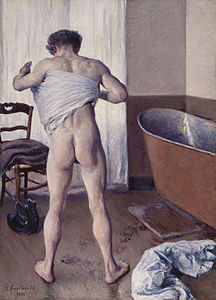- Charles Bird King, Still Life on a Green Table Cloth, 1815

 Fitz Henry Lane, Salem Harbor, 1853
Fitz Henry Lane, Salem Harbor, 1853- Martin Johnson Heade, Passion Flowers and Hummingbirds, c. 1870-1873
- William Rimmer, Flight and Pursuit, 1872
- Mary Cassatt, Tea, 1880
- Winslow Homer, The Fog Warning, 1885
 Childe Hassam, At Dusk (Boston Common at Twilight), 1886
Childe Hassam, At Dusk (Boston Common at Twilight), 1886
art.wikisort.org - Museum
The Museum of Fine Arts (often abbreviated as MFA Boston or MFA) is an art museum in Boston, Massachusetts. It is the 20th-largest art museum in the world, measured by public gallery area. It contains 8,161 paintings and more than 450,000 works of art, making it one of the most comprehensive collections in the Americas. With more than 1.2 million visitors a year,[2] it is the 52nd–most visited art museum in the world as of 2019[update].
 | |
 Museum of Fine Arts main entrance with the Appeal to the Great Spirit statue | |
 Location within Boston  Museum of Fine Arts, Boston (Massachusetts)  Museum of Fine Arts, Boston (the United States) | |
 Interactive fullscreen map | |
| Established | 1870 |
|---|---|
| Location | 465 Huntington Avenue Boston, MA 02115 |
| Coordinates | 42°20′21″N 71°5′39″W |
| Type | Art museum |
| Accreditation | AAM NARM |
| Visitors | 1,249,080 (2019)[1] |
| Director | Matthew Teitelbaum |
| Architect | Guy Lowell |
| Public transit access | Green Line (E branch) Museum of Fine Arts Orange Line Ruggles Franklin Line Ruggles Providence/Stoughton Line Ruggles |
| Website | mfa.org |
Founded in 1870 in Copley Square, the museum moved to its current Fenway location in 1909. It is affiliated with the School of the Museum of Fine Arts at Tufts.
History
1870–1907
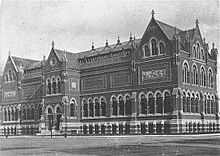
The Museum of Fine Arts was founded in 1870 and was initially located on the top floor of the Boston Athenaeum. Most of its initial collection came from the Athenæum's Art Gallery.[3] Francis Davis Millet, a local artist, was instrumental in starting the art school affiliated with the museum, and in appointing Emil Otto Grundmann as its first director.[4] In 1876, the museum moved to a highly ornamented brick Gothic Revival building designed by John Hubbard Sturgis and Charles Brigham, noted for its massed architectural terracotta. It was located in Copley Square at Dartmouth and St. James Streets.[3] It was built almost entirely of brick and terracotta, which was imported from England, with some stone about its base.[5] After the MFA moved out in 1907, this original building was demolished, and the Copley Plaza Hotel (now the Fairmont Copley Plaza) replaced it in 1912.[6]
1907–2008
In 1907, plans were laid to build a new home for the museum on Huntington Avenue in Boston's Fenway–Kenmore neighborhood, near the recently opened Isabella Stewart Gardner Museum. Museum trustees hired architect Guy Lowell to create a design for a museum that could be built in stages, as funding was obtained for each phase. Two years later, the first section of Lowell's neoclassical design was completed. It featured a 500-foot (150 m) façade of granite and a grand rotunda. The museum moved to its new location later in 1909.
The second phase of construction built a wing along The Fens to house paintings galleries. It was funded entirely by Maria Antoinette Evans Hunt, the wife of wealthy business magnate Robert Dawson Evans, and opened in 1915. From 1916 through 1925, the noted artist John Singer Sargent painted the frescoes that adorn the rotunda and the associated colonnades.
The Decorative Arts Wing was built in 1928, and expanded in 1968. An addition designed by Hugh Stubbins and Associates was built in 1966–1970, and another expansion by The Architects Collaborative opened in 1976. The West Wing, now the Linde Family Wing for Contemporary Art, was designed by I. M. Pei and opened in 1981. This wing now houses the museum's cafe, restaurant, meeting rooms, classrooms, and a giftshop/bookstore, as well as large exhibition spaces.

The Tenshin-En Japanese Garden designed by Kinsaku Nakane opened in 1988, and the Norma Jean Calderwood Garden Court and Terrace opened in 1997.[7][3]
2008–present
In the mid-2000s, the museum launched a major effort to renovate and expand its facilities. In a seven-year fundraising campaign between 2001 and 2008 for a new wing, the endowment, and operating expenses, the museum managed to receive over $500 million, in addition to acquiring over $160 million worth of art.[8]
During the global financial crisis between 2007 and 2012, the museum's annual budget was trimmed by $1.5 million. The museum increased revenues by organizing traveling exhibitions, which included a loan exhibition sent to the for-profit Bellagio in Las Vegas in exchange for $1 million. In 2011, Moody's Investors Service calculated that the museum had over $180 million in outstanding debt. However, the agency cited growing attendance, a large endowment, and positive cash flow as reasons to believe that the museum's finances would become stable in the near future.
In 2011, the museum put eight paintings by Monet, Renoir, Pissarro, Sisley, Gauguin, and others on sale at Sotheby's, bringing in a total of $21.6 million, to pay for Man at His Bath by Gustave Caillebotte at a cost reported to be more than $15 million.[9]
A renovation included the new Art of the Americas Wing, featuring artwork from North, South, and Central America. In 2006, the groundbreaking ceremonies took place. The new wing and adjoining Ruth and Carl J. Shapiro Family Courtyard (a bright, cavernous interior space) were designed in a restrained, contemporary style by the London-based architectural firm Foster and Partners, under the directorship of Thomas T. Difraia and Childs Bertman Tseckares Architects (CBT). The landscape architecture firm Gustafson Guthrie Nichol redesigned the Huntington Avenue and Fenway entrances, gardens, access roads, and interior courtyards.
The wing opened on November 20, 2010, with free admission to the public. Mayor Thomas Menino declared it "Museum of Fine Arts Day", and more than 13,500 visitors attended the opening. The 12,000-square-foot (1,100 m2) glass-enclosed courtyard now features a 42.5-foot (13.0 m) high glass sculpture, titled the Lime Green Icicle Tower, by Dale Chihuly.[10] In 2014, the Art of the Americas Wing was recognized for its high architectural achievement by the award of the Harleston Parker Medal, by the Boston Society of Architects.
In 2015, the museum renovated its outdoors Japanese garden, Tenshin-en. The garden, which originally opened in 1988, had been designed by Japanese professor Kinsaku Nakane. The garden's kabukimon-style entrance gate was built by Chris Hall of Massachusetts, using traditional Japanese carpentry techniques.[11][12]
On March 12, 2020, the museum announced that it would close indefinitely due to the COVID-19 pandemic. All public events and programs were canceled until August 31, 2020. The museum reopened on September 26, 2020.[13]
Collection

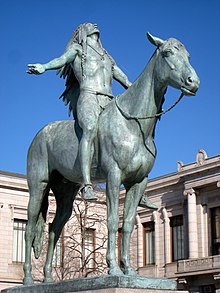
The Museum of Fine Arts possesses materials from a wide variety of art movements and cultures. The museum also maintains a large online database with information on over 346,000 items from its collection, accompanied with digitized images. Online search is freely available through the Internet.[14]
Some highlights of the collection include:
- Ancient Egyptian artifacts including sculptures, sarcophagi, and jewelry
- Dutch Golden Age painting, including 113 works given in 2017 by collectors Rose-Marie and Eijk van Otterloo and Susan and Matthew Weatherbie.[15] The gift includes works from 76 artists, as well as the Haverkamp-Begemann Library, a collection of more than 20,000 books, donated by the van Otterloos. The donors are also establishing a dedicated Netherlandish art center and scholarly institute at the museum.[16]
- French impressionist and post-impressionist works by artists such as Paul Gauguin, Édouard Manet, Pierre-Auguste Renoir, Edgar Degas, Claude Monet, Camille Pissarro, Vincent van Gogh, and Paul Cézanne
- 18th- and 19th-century American art, including many works by John Singleton Copley, Winslow Homer, John Singer Sargent, and Gilbert Stuart
- Chinese painting, calligraphy and imperial Chinese art
- The largest collection of Japanese artworks under one roof in the world outside Japan
- The Hartley Collection of almost 10,000 British illustrated books, prints and drawings from the late 19th century
- The Rothschild Collection, including over 130 objects from the Austrian branch of the Rothschild family. Donated by Bettina Burr and other heirs[17]
- The Rockefeller collection of Native American work[18]
- The Linde Family Wing for Contemporary Art includes works by Kathy Butterly, Mona Hatoum, Jenny Holzer, Karen LaMonte, Ken Price, Martin Puryear, Doris Salcedo, and Andy Warhol.[19]
Japanese art

The collection of Japanese art at the Museum of Fine Arts is the largest in the world outside of Japan. Anne Nishimura Morse, the William and Helen Pounds Senior Curator of Japanese Art, oversees 100,000 total items[20] that include 4,000 Japanese paintings, 5,000 ceramic pieces, and over 30,000 ukiyo-e prints.[21][22]
The base of this collection was assembled in the late 19th century through the efforts of four men, Ernest Fenollosa, Kakuzo Okakura, William Sturgis Bigelow, and Edward Sylvester Morse, each of whom had spent time in Japan and admired Japanese art.[20][23] Their combined donations account for up to 75 percent of the current collection.[20] In 1890, the Museum of Fine Arts became the first museum in the United States to establish a collection and appoint a curator specifically for Japanese art.[21][24]
Another notable part of this collection is a number of Buddhist statues. In the later Meiji era of Japan, around the turn of the 20th century, government policy deemphasizing Buddhism in favor of Shintoism and financial pressures on temples resulted in a number of Buddhist statues being sold to private collectors. Some of these statutes came into the collection of the Museum of Fine Arts.[25][26] Today, these statues are the subject of preservation and restoration efforts, which have been at times viewable by the public in special exhibits.[26][27] In recent years, the museum has also collected a number of works by contemporary Japanese artists. In 2011, they acquired Zetsu no. 8 (絶), the largest work in ceramicist Jun Nishida's Zetsu (絶) series.[28]
Also important for this collection is the exhibition of its items in Japan. From 1999 to 2018, regular exchange of items was conducted between the Museum of Fine Arts and its sister museum, the now-closed Nagoya/Boston Museum of Fine Arts.[21][29] In 2012, the traveling exhibition Japanese Masterpieces from the Museum of Fine Arts, Boston visited the Japanese cities of Tokyo, Nagoya, Osaka and Fukuoka, and was well received.[20][21][30]
Libraries
The libraries at the Museum of Fine Arts collectively house 320,000 items.[31] The main branch, the William Morris Hunt Memorial Library, is named after the noted American artist. For decades, it was located off-site in Horticultural Hall, two stops away on the MBTA Green Line. The main library had been open to the public, and the catalog could be searched online.
In 2021, the Horticultural Hall location was closed, in preparation for a move into the main MFA complex. The new home for the library is on the first floor of the museum near Sharf Information Center, in front of the Nina Saunders Suite. About a quarter of the collection is to be housed on the third floor of the museum along with the book conservation space, with the remainder stored off-site.[32]
As of September 2022[update], the library has not been re-opened to the public, although staff access has been restored.[31]
Exhibitions organized by the library staff in coordination with the School of the Museum of Fine Arts at Tufts are opened two to three times per year.[33]
CAMEO
The Conservation and Art Materials Encyclopedia Online, (CAMEO) is a database that "compiles, defines, and disseminates technical information on the distinct collection of terms, materials, and techniques used in the fields of art conservation and historic preservation".[34] CAMEO uses MediaWiki.[35]
Community relations
The MFA has gradually been expanding its programs of community outreach to people who have not been traditional visitors, and this trend accelerated after Matthew Teitelbaum was appointed as Director in 2015. This expansion has included improved accessibility for visitors who may be visually, audibly, or physically impaired.[36] Special programming and tours are available for blind, ASL-fluent, cognitively-impaired, autistic, and medically-assisted guests.[37] In addition, the MFA has welcomed LGBTQ visitors with exhibitions like Gender Bending Fashion (2019), and in spring 2019 it installed universally welcoming signage for restrooms.[38]
Starting in July 2017, the MFA has offered a free one-year family membership to all newly naturalized US citizens under its "MFA Citizens" program.[39][40]
The MFA publicly apologized[41] in May 2019 after African-American and mixed-race 12- and 13-year-old visitors were allegedly targeted by employees and told "No food, no drink, and no watermelon", which is considered a racial slur in the US. A museum spokesperson said that the warning was actually "no water bottles", but conceded that there was no way of definitively proving what was actually said. Regardless, all museum staff dealing with school groups were to be retrained in interactions with their guests. The MFA also concluded that two of its members had been deliberately racist, and permanently banned them from visiting its grounds.[42][43][44]
On October 14, 2019, the MFA debuted its newly renamed "Indigenous Peoples’ Day" (formerly Columbus Day) celebrations, with a focus on Native American art and culture.[45] The events included special displays related to Cyrus Dallin’s 1908 Appeal to the Great Spirit, a popular and sometimes controversial sculpture of a Native American warrior located in front of the Huntington Avenue main entrance since 1912. Community comments and feedback concerning the monumental artwork were solicited and displayed.[45] Earlier, in March 2019, the MFA had held a special public symposium to discuss the historical background and present-day significance of the iconic sculpture.[46]
In 2020 the MFA offered 11 annual Community Celebrations, featuring free admission for all visitors, and special events such as dance performances, music, tours, craft demonstrations, and hands-on art making. This series included day-long Martin Luther King Jr. Day, Lunar New Year, Memorial Day, Highland Street Foundation Free Fun Friday, and Indigenous Peoples' Day celebrations. In addition, on Wednesday evenings, which were already free from 4pm to 10pm, special celebrations of Nowruz, Juneteenth, Latinx Heritage Night, ASL Night, Diwali, and Hanukkah were featured.[47]
To commemorate its 150th anniversary, the MFA offered a free one-year family membership to anyone who attended one of its special Community Celebrations or MFA Late Nite programs during 2020. This "First Year Free Membership" program was available to anyone who had not previously been a member of the museum.[48] The 150th year exhibitions included major shows and events featuring art by women and minority artists.[49][50][51]
In November 2020 a significant number of MFA employees voted to unionize due to a long history of unaddressed issues related to workplace conditions and compensation inequities.[52] The workers unionized with the local chapter of the United Auto Workers. After over 96% of the union agreed in a vote, MFA staff went on a strike for the first time on November 17, 2021. Union representatives cited unresponsive engagement from MFA management over multiple issues including stagnant wages, job security, and workplace diversity, as the reason for the strike.[53] The union pointed out that employee wages had been frozen for two years, and that management had so far only offered a 1.75% percent raise over the course of four years. Union representatives contrasted this with MFA director Matthew Teitelbaum's salary which, clocking in at nearly 1 million USD, was almost 19 times larger than the average MFA worker.[54]
In September 2022, as the MFA sought to recover from a precipitous drop in attendance caused by the COVID-19 pandemic, a new logo and branding campaign were announced, along with renewed community outreach efforts. These changes were announced in tandem with the opening of the traveling exhibition of an official portrait of former US president Barack Obama by Kehinde Wiley and the accompanying portrait of Michelle Obama by Amy Sherald, both on loan from the National Portrait Gallery in Washington DC.[55]
Highlights
Among the many notable works in the collection, the following examples are in the public domain and have photographs available:
American
- John Singleton Copley, Paul Revere, 1768
- Gilbert Stuart, George Washington, 1796
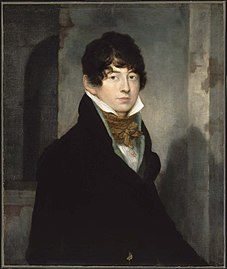 Washington Allston, Self-Portrait, 1805
Washington Allston, Self-Portrait, 1805- Mary Cassatt, In the Loge, 1878
European
- Claude Lorrain, Apollo and the Muses on Mount Helion, 1680
- Corrado Giaquinto, Adoration of the Magi, 1725
- Giovanni Paolo Panini, Picture Gallery with Views of Modern Rome, 1757
- J.M.W. Turner, The Slave Ship 1840
- Henri Regnault, Automedon with the Horses of Achilles, 1868
- Edgar Degas, At the Races in the Countryside, 1869
- Edgar Degas, Racehorses at Longchamp, 1873–1875
- Claude Monet, Poppy Field in a Hollow near Giverny, 1888
- Paul Gauguin, Where Do We Come From? What Are We? Where Are We Going?, 1897
- Rogier van der Weyden, Saint Luke Drawing the Virgin, 1435-1440
- Rosso Fiorentino, The Dead Christ with Angels, 1524-1527
- El Greco, Fray Hortensio Félix Paravicino, 1609
- Diego Velázquez, Don Baltasar Carlos with a Dwarf, 1632
- Francisco Goya, Seated Giant, 1818
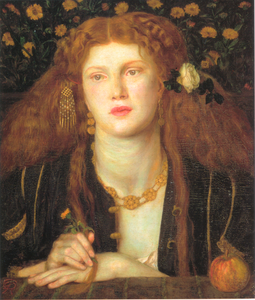
- Édouard Manet, Street Singer, 1862
- Claude Monet, La Japonaise, 1876
- Paul Cézanne, Madame Cézanne in a Red Armchair, 1877
- Auguste Renoir, Dance at Bougival, 1883
- Gustave Caillebotte, Man at His Bath, 1884
- Vincent van Gogh, La Berceuse, 1889
Antiquities
- Ramesses III prisoner tiles
- King Menkaura (Mycerinus) and queen, 2490–2472 BCE
- Winged Protective Deity, 883–859 BCE
- Goddess Tawaret, 623–595 BCE
- Marine Mosaic, 200–230 CE
Notable people
Directors
- Emil Otto Grundmann – first Director
- Edward Robinson – second Director
- Arthur Fairbanks – third Director
- George Harold Edgell – fifth Director
- Perry T. Rathbone – sixth Director
- Merrill C. Rueppel – seventh Director
- Jan Fontein – eighth Director
- Alan Shestack – ninth Director
- Morton Golden - interim Director 1993-1994
- Malcolm Rogers – tenth Director
- Matthew Teitelbaum – eleventh Director
Curators
- Sylvester Rosa Koehler – first Curator of Prints (1887–1900)
- Ernest Fenollosa – Curator of Oriental Art (1890–1896)
- Benjamin Ives Gilman – Curator (1893–1894?); Librarian (1893–1904); Secretary (1894–1925) Assistant Director (1901–1903); Temporary Director (1907)
- Albert Lythgoe – first Curator of Egyptian Art (1902–1906)[56]
- Okakura Kakuzō – Curator of Oriental Art (1904–1913)
- Fitzroy Carrington – Curator of Prints (1912–1921)
- Ananda Coomaraswamy – Curator of Oriental Art (1917–1933)
- William George Constable – Curator of Paintings (1938–1957)
- Cornelius Clarkson Vermeule III – Curator of Classical Art (1957–1996)
- Jonathan Leo Fairbanks – Curator of American Decorative Arts and Sculpture (1970–1999)
- Theodore Stebbins – Curator of American Paintings (1977–1999)
- Anne Poulet – Curator of Sculpture and Decorative Arts (1979–1999)
Bulletin
A bulletin appeared under various titles from 1903 to 1983:[57]
- 1903–1925: Museum of Fine Arts Bulletin
- 1926–1965: Bulletin of the Museum of Fine Arts
- 1966–1977: Boston Museum Bulletin
- 1978–1980: MFA Bulletin
- 1981–1983: M Bulletin (Museum of Fine Arts, Boston)
See also
- List of most-visited museums in the United States
- The Lonely Palette (art history podcast hosted by MFA lecturer Tamar Avishai)
- Nagoya/Boston Museum of Fine Arts (defunct sister institution in Nagoya, Japan)
- School of the Museum of Fine Arts at Tufts
References
- "Visitor Figures 2016" (PDF). The Art Newspaper Review. April 2017. p. 14. Retrieved 23 March 2018.
- "Museum of Fine Arts Annual Report". Museum of Fine Arts. Retrieved 20 May 2016.
- Southworth, Susan & Southworth, Michael (2008). AIA Guide to Boston (3rd ed.). Guilford, Connecticut: Globe Pequot Press. pp. 345–47. ISBN 978-0-7627-4337-7.
- Natasha. "John Singer Sargent Virtual Gallery". Jssgallery.org. Retrieved 2012-12-17.
- "An announcement was made..." (hathitrust.org). The Brickbuilder. Boston, MA: Rodgers & Manson. 8 (12): 237. December 1899. Retrieved 7 March 2015.
- "Preserving History Chronicles The Museum of Fine Arts, Boston, Since Its Founding in 1870". artdaily.cc. Royalville Communications, Inc. Retrieved 2020-02-27.
- "Architectural History - Museum of Fine Arts, Boston". Museum of Fine Arts, Boston. 2010-10-11. Retrieved March 4, 2012.
- Dobrzynski, Judith H. (10 November 2010). "Boston Museum Grows by Casting a Wide Net". The New York Times. Retrieved 14 May 2016.
- Judith H. Dobrzynski (March 14, 2012), "How an Acquisition Fund Burnishes Reputations". The New York Times.
- "Lime Green Icicle Tower". Museum of Fine Arts. Retrieved October 26, 2014.
- "Japanese Garden, Tenshin-en". Boston Museum of Fine Arts. 2015-03-13. Retrieved 16 August 2015.
- Takes, Joanna Werch (January 20, 2015). "Chris Hall: A (Japanese-Inspired) Timber Framing Philosophy for Furniture". Woodworker's Journal. Retrieved 16 August 2015.
- "MFA Boston Will Reopen September 26 with Art of the Americas Galleries, "Women Take the Floor" and "Black Histories, Black Futures"". MFA. September 9, 2020.
- "Advanced Search Objects – Museum of Fine Arts, Boston". Museum of Fine Arts, Boston. Retrieved 2020-02-19.
- "Museum of Fine Arts, Boston, to Receive Landmark Gifts of Dutch and Flemish Art Including Rembrandt Portrait and Other Golden Age Masterpieces". Museum of Fine Arts, Boston. Retrieved 2017-10-12.
- Massive gift of Dutch art is a coup for MFA - The Boston Globe
- "Museum of Fine Arts, Boston, Announces Major Gift from Rothschild Heirs, Including Family Treasures Recovered from Austria after WWII." Museum of Fine Arts, Boston. 22 February 2015. Retrieved 3 March 2015.
- "Acquisitions of the month: October 2018". Apollo Magazine. 2018-11-09.
- "Contemporary Art". Museum of Fine Arts, Boston. Retrieved 2020-02-18.
- "Spotlight on panelist Dr. Anne Nishimura Morse, curator of Japanese art at the Museum of Fine Arts, Boston". Conference on Cultural and Educational Interchange (CULCON). 2012-08-17. Retrieved 2020-07-07.
- "Art of Japan Collection and History of Cultural Exchange". Museum of Fine Arts, Boston. Retrieved 2020-07-08.
- "Museum of Fine Arts Boston: Japanese Collections". North American Coordinating Council on Japanese Library Resources. Retrieved 2020-07-08.
- Adamson, Glenn (2020-06-13). "The Museum of Fine Arts in Boston turns 150". Apollo Magazine. Retrieved 2020-07-07.
- Khvan, Olga (2015-04-03). "Two New Exhibits Tell Story of Japanese Art at MFA Boston". Boston Magazine. Retrieved 2020-07-08.
- Hintermeister, Henry (2018-02-20). "An Art History". The Tufts Observer. Retrieved 2020-07-08.
- Billman, Ty (2020-06-12). "A Critical Moment for Japanese Art Curation". Kyoto Journal. Retrieved 2020-07-07.
- "Conservation in Action: Japanese Buddhist Sculpture in a New Light". Museum of Fine Arts, Boston. Retrieved 2020-07-08.
- Hykin, Abigail; Morse, Anne Nishimura (2014). "An Exploration of Finality: Conservator and Curator Examine the Ceramic Sculpture of Nishida Jun". Impressions (35): 84–95. ISSN 1095-2136.
- "'In Pursuit of Happiness: Favorite Works from the Museum of Fine Arts, Boston". The Japan Times. Retrieved 2018-10-08.
- "Japanese Masterpieces from the Museum of Fine Arts, Boston". Tokyo National Museum. Retrieved 2020-07-08.
- "MFA Library: William Morris Hunt Memorial Library: Home". library.mfa.org. Museum of Fine Arts Boston. Retrieved 2020-02-29.
- "MFA Library: William Morris Hunt Memorial Library: Library Newsletter". library.mfa.org. MFA Boston. Retrieved 2022-09-05.
- "MFA Library: William Morris Hunt Memorial Library: Exhibitions". library.mfa.org. Museum of Fine Arts Boston. Retrieved 2020-02-29.
- "About CAMEO". CAMEO: Conservation and Art Materials Encyclopedia Online. Museum of Fine Arts, Boston. Retrieved 18 December 2021.
- "MediaWiki API help". CAMEO. cameo.mfa.org. Retrieved 18 December 2021.
- "Accessibility". Museum of Fine Arts, Boston. Retrieved 2020-02-19.
- "Access Programs". Museum of Fine Arts, Boston. Retrieved 2020-02-19.
- "Tips for Visitors". Museum of Fine Arts, Boston. Retrieved 2020-02-19.
- "MFA Citizens". Museum of Fine Arts, Boston. Retrieved 2020-02-19.
- McCambridge, Ruth (15 May 2018). "Boston's Museum of Fine Arts Hosts a New and Perfect Kind of Event". Nonprofit Quarterly. Retrieved 2020-03-08.
- "Museum of Fine Arts, Boston, Announces Steps to Address Results of Investigation into Davis Leadership Academy Group Visit on May 16, 2019". Museum of Fine Arts, Boston. Retrieved 2020-02-19.
- Sini, Rozina (May 25, 2019). "Boston museum sorry for racist 'no watermelons' remark". BBC News. Retrieved May 25, 2019.
- Garcia, Maria (May 24, 2019). "MFA Bans 2 Patrons After Students of Color Say They Were Subjected to Racist Comments". WBUR. Retrieved May 28, 2019.
- Farzan, Antonia Noori (May 24, 2019). "Black students on a field trip said they were told 'no food, no drink, no watermelon.' Now the museum is apologizing". Washington Post. Retrieved 2020-02-19.
- "Museum of Fine Arts, Boston, Honors Indigenous Peoples' Day with Launch Of Free Community Celebration That Places Native American Voices at the Forefront". Museum of Fine Arts, Boston. Retrieved 2020-02-19.
- "Dallin experts discuss sculptor's work, 'Appeal to the Great Spirit'". The Arlington Advocate. March 12, 2019. Retrieved 2020-02-19.
- "Community Celebrations". Museum of Fine Arts, Boston. Archived from the original on 2020-04-25. Retrieved 2021-04-29.
{{cite web}}: CS1 maint: unfit URL (link) - "First Year Free Membership". Museum of Fine Arts, Boston. Retrieved 2020-02-19.
- "Museum of Fine Arts, Boston's 150th Anniversary Honors the Past and Reimagines the Future". Museum of Fine Arts, Boston. Retrieved 2020-02-19.
- Close, Cynthia (December 27, 2019). "MFA, Boston Turns 150: Here's How They're Celebrating". Art & Object. Retrieved 2020-03-08.
- Chew, Hannah T. (October 1, 2019). "MFA's 150th Anniversary to Honor the Past and Reimagine the Future". The Harvard Crimson. Retrieved 2020-03-08.
- "In a Landslide Decision, Workers at the Museum of Fine Arts in Boston Become the Latest Major American Museum Staff to Unionize". 23 November 2020.
- Lonas, Lexi (2021-11-12). "Workers at Boston Museum of Fine Arts vote to hold one-day strike". The Hill.
{{cite web}}: CS1 maint: url-status (link) - Levin, Annie (2021-11-17). "MFA Boston Staff Hold One-Day Strike for a Fair Contract". Observer.
{{cite web}}: CS1 maint: url-status (link) - Shea, Andrea (September 3, 2022). "Museum of Fine Arts hosts the Obama portraits and unveils a new look". www.wbur.org. WBUR. Retrieved 2022-09-05.
- Bierbrier, Morris L (2012). Who Was Who in Egyptology, 4th edition. Egypt Exploration Society. p. 244. ISBN 978-0856982071.
- "Museum of Fine Arts Bulletin on JSTOR". JSTOR / Museum of Fine Arts, Boston. Retrieved October 8, 2017.
External links
- Official site
- Virtual tour of the Museum of Fine Arts, Boston provided by Google Arts & Culture
 Media related to Museum of Fine Arts, Boston at Wikimedia Commons
Media related to Museum of Fine Arts, Boston at Wikimedia Commons
На других языках
[de] Museum of Fine Arts, Boston
Das Museum of Fine Arts, Boston (deutsch: Museum der Schönen Künste) ist ein Kunstmuseum in Boston, Massachusetts, Vereinigte Staaten, und ist eines der größten Museen des Landes.- [en] Museum of Fine Arts, Boston
[ru] Музей изящных искусств (Бостон)
Музей изящных искусств в Бостоне (англ. The Museum of Fine Arts; сокр. MFA) — один из крупнейших художественных музеев США.Другой контент может иметь иную лицензию. Перед использованием материалов сайта WikiSort.org внимательно изучите правила лицензирования конкретных элементов наполнения сайта.
WikiSort.org - проект по пересортировке и дополнению контента Википедии









